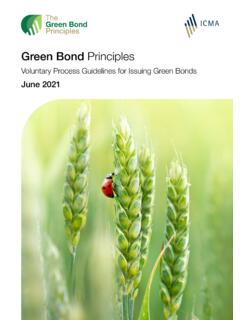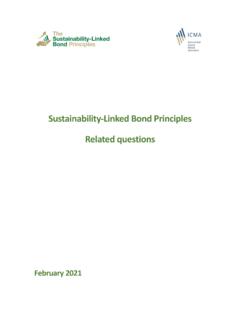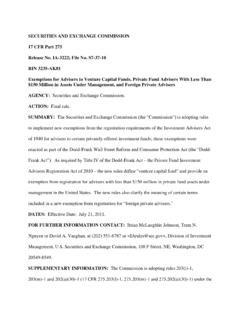Transcription of Handbook - International Capital Market Association
1 HandbookHarmonized Framework for Impact ReportingHandbookHarmonised Framework for Impact ReportingJune 2021 Handbook Harmonised Framework for Impact Reporting June 20212 DisclaimerThe information in this document has been provided by third-party sources and is intended for general information only (the Information ), and is not intended to be and should not be relied upon as being legal, financial, investment, tax, regulatory, business or other professional advice. ICMA and the Green Bond Principles are not responsible for the accuracy, reliability, currency or completeness of the Information. ICMA and the Green Bond Principles do not represent nor warrant that the Information is accurate, suitable or complete and neither ICMA, its employees or representatives, nor the Green Bond Principles or its members shall have any liability arising from or relating to its compilation of this Handbook was led by an informal Technical Working Group comprising EBRD, EIB, International Finance Corporation (IFC), KfW, NIB and the World Bank.
2 Special thanks are extended to this Technical Working Group, for their detailed work, that drove the preparation of this document as well as to the 4 Multilateral Development Banks (AfDB, EIB, IFC and World Bank) that published the first Harmonised Framework for Impact Reporting in March 2015, and the 11 International Financial Institutions (IFIs) that published the updated version in December 2015. The material also benefitted from generous input from members of the Impact Reporting Working Group, coordinated by EBRD and KfW, with support from ICMA. The 11 International Financial Institutions (IFIs) that published Working Towards a Harmonised Framework for Impact Reporting in December 2015 are: The GBP Impact Reporting Working Group currently consists of the following organisations:Working Group Coordinators:European Bank for Reconstruction and Development (EBRD) KfW KommunalBanken (KBN) Nordic Investment Bank (NIB)Working Group Members.
3 ActiamAmerican Carbon RegistryAmundiAnglian WaterAshurst HKAxa IMBank of America Merrill LynchBlackRockBNP ParibasCarbone4 Cassa Depositi e PrestitiCeresCICERO Shades of GreenClimate Bond InitiativeEDFE uropean Investment Bank (EIB)HSBCI-Care & ConsultICE Data ServicesImpact Investment Exchange (IIX)INGI nter-American development Bank (IADB) International Finance Corporation (IFC)Institutional Shareholder Services (ISS)London Stock Exchange Luxembourg Stock ExchangeMainstreet Investment PartnersMirovaMizuho InternationalMoody sMorgan StanleyNatixisNordeaOP Corporate BankPIMCOR ating and Investment InformationSantander CIBSFIL/CAFFILS kandinaviska Enskilda Banken (SEB)Social Value InstituteSoci t G n raleSouth PoleSustainalyticsUN WomenWhite & CaseWorld BankWorld Wide Fund for Nature (WWF)Yale Initiative on Sustainable FinanceZurich Insurance Handbook Harmonised Framework for Impact Reporting June 20213 ContentsI.
4 Introduction 4II. Background History 5 III. Core Principles and Recommendations for Reporting 7IV. Sector Specific Guidance and Reporting Metrics 101. Renewable Energy 10 Core Indicators 10 Other Indicators (Examples) 102. Energy Efficiency 11 Core Indicators 11 Other Indicators (Examples) 113. Sustainable Water and Wastewater Management 12 Core Indicators 13 Other Sustainability Indicators 144. Waste Management and Resource Efficiency 15 Guidance and Definitions 16 Core Indicators 17 Other Sustainability Indicators 195. Clean Transportation 20 Guidance and Definitions 21 Core Indicators 22 Other Sustainability Indicators 236. Green Buildings 24 Guidance and Definitions 25 Core Indicators 26 Other Sustainability Indicators 277. Biodiversity 28 Core Indicators 29 Other Sustainability Indicators 30 Guidance and Definitions for Additional Human Rights and Social Disclosures 308.
5 Climate Change Adaptation 31 Exemplary Indicators 33 Other Sustainability Indicators 34 Appendix 359. Circular Economy and/or Eco-Efficient Projects 36 Core Indicators for Circular Economy and Eco-Efficiency Projects: 38 Other Sustainability Indicators for Circular Economy and Eco-Efficiency Projects: 40 Glossary of Terms Used for Circular Economy and Eco-Efficiency Projects: 41V. Reporting Templates 43 Renewable Energy 43 Energy Efficiency 44 Sustainable Water and Wastewater Management 45 Waste Management and Resource-Efficiency 47 Clean Transportation 49 Green Buildings 51 Biodiversity 52 Climate Change Adaptation 54 Circular Economy and/or Eco-Efficient Projects 58 Notes 62 Handbook Harmonised Framework for Impact Reporting June 20214I.
6 IntroductionThe overall goal of the green bond Market is to promote and amplify the important role that financial markets can play in helping to address environmental issues. By explicitly specifying the environmentally beneficial projects to which the bond proceeds are allocated, Green Bonds allow investors to assess and allocate Capital to environmentally sustainable investments. It is assumed that the green bonds referred to in this document are aligned with the Green Bond Principles (GBP)1. The GBP help enhance the integrity and transparency of environmental finance, including through recommending impact reporting. In March 2015, a working group of four Multilateral Development Banks (AfDB, EIB, IFC and World Bank) developed and published the first Harmonised Framework for Impact Reporting, that was later revised and republished by 11 International Financial Institutions (IFIs).
7 2 The framework outlined core principles and recommendations for impact reporting in order to provide issuers with reference and guidance for the development of their own reporting and provided core indicators and reporting templates for Energy Efficiency and Renewable Energy Projects. Successively, harmonised frameworks for impact reporting on further categories of eligibility for Green Projects under the GBP have been released. Sectors so far covered are: Sustainable Water and Wastewater Management Projects (June 2017), Sustainable Waste Management and Resource-Efficiency Projects (February 2018), Clean Transportation Projects (June 2018), Green Building Projects (February 2019), Biodiversity Projects (April 2020) and Climate Change Adaptation Projects (December 2020). These harmonised frameworks summarise the conclusions of informal technical working groups3, which have received broader input through the Impact Reporting Working Group convened by the GBP Executive Committee.
8 This Handbook unites the above mentioned harmonised frameworks in one document preserving the content of the initial documents. The objective is to enhance the usability of the initial documents and to avoid repetitions. Reporting is a core component of the GBP. Issuers are required to report on the use of proceeds by providing a list of the projects to which Green Bond proceeds have been allocated and a brief description of the projects and their expected impact. In certain cases the information can be presented in generic terms or on an aggregated portfolio basis. The GBP recommend the use of both qualitative performance indicators and, where feasible, quantitative performance measures with the disclosure of the key underlying methodology and/or assumptions used in the quantitative determination. This Handbook outlines general core principles and recommendations for reporting in order to provide issuers with a reference as they develop their own reporting.
9 This Handbook also offers impact reporting metrics and sector specific guidance for the aforementioned project categories. In Chapter V of this Handbook , reporting templates are included for issuers to use and adapt to their own circumstances. These templates make reference to the most commonly used indicators. Other indicators, however, might be relevant as well. All recommendations, indicators and templates need to be compatible with different approaches to the management of proceeds, which can be based on allocations to either individual projects or project document does not, at this stage, cover impact reporting on projects under the GBP category of environmentally sustainable management of living natural resources and land use . However, the authors of this document acknowledge the importance of harmonised metrics also for such projects, for which additional suitable indicators are to be developed in the future and added to this is acknowledged that there are also other initiatives in the Market that provide guidance on impact reporting including by green bond Market See: Participants: African Development Bank (AfDB), Agence Fran aise de D veloppement (AFD), Asian Development Bank (ADB), European Bank for Reconstruction and Development (EBRD), European Investment Bank (EIB), Inter-American Development Bank (IDB), International Bank for Reconstruction and Development (IBRD), International Finance Corporation (IFC), Kreditanstalt f r Wiederaufbau (KfW), Nederlandse Financierings-Maatschappij voor Ontwikkelingslanden (FMO), and Nordic Investment Bank (NIB).
10 3 The members of the respective working groups are mentioned under II. Background History4 For example: Nordic Public Sector Issuers Position Paper on Green Bonds Impact Reporting Handbook Harmonised Framework for Impact Reporting June 20215II. Background History In November 2013, a group of investors, issuers and Market intermediaries gathered at a Symposium hosted by the World Bank5 to discuss the green bond Market and what is needed to help it achieve its purpose. Investors recognised a need for more transparency around the use of proceeds as well as further development in the area of impact reporting, and encouraged participating MDBs to help develop guidance on a common approach, building on ongoing work among a broader group of IFIs to develop harmonised approaches for GHG accounting. In January 2014, the Green Bond Principles (GBP), a voluntary set of guidelines, were published at the initiative of Capital Market intermediaries that recommended transparency and disclosure to promote integrity in the development of the green bond Market by clarifying the cornerstones of green bond issuance.












